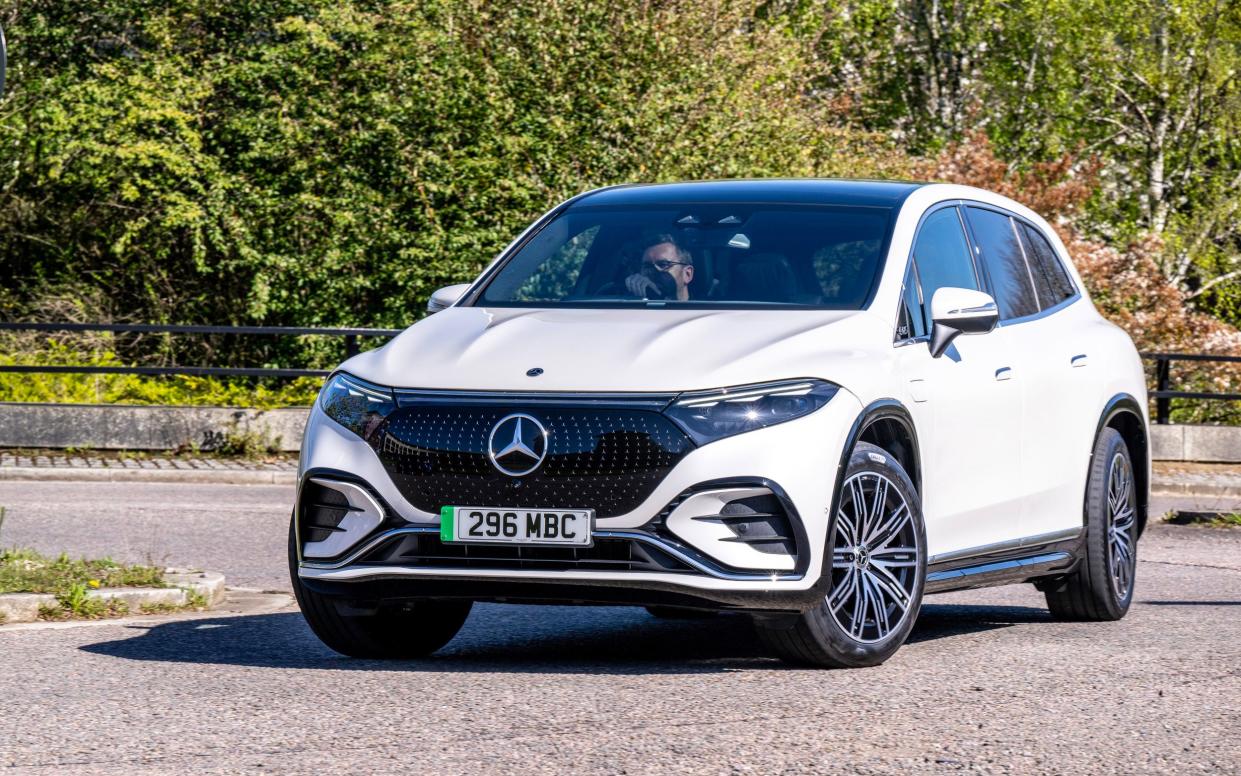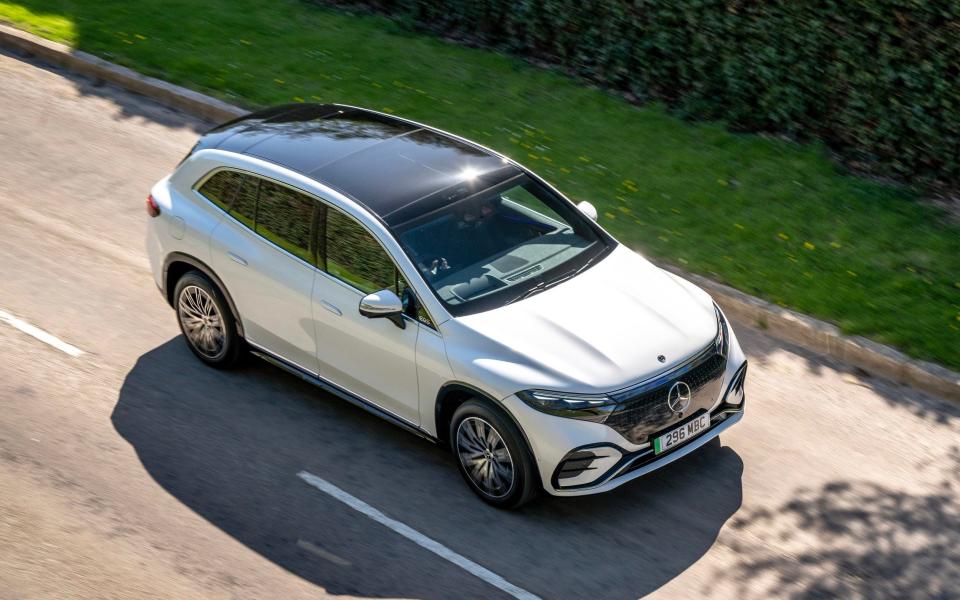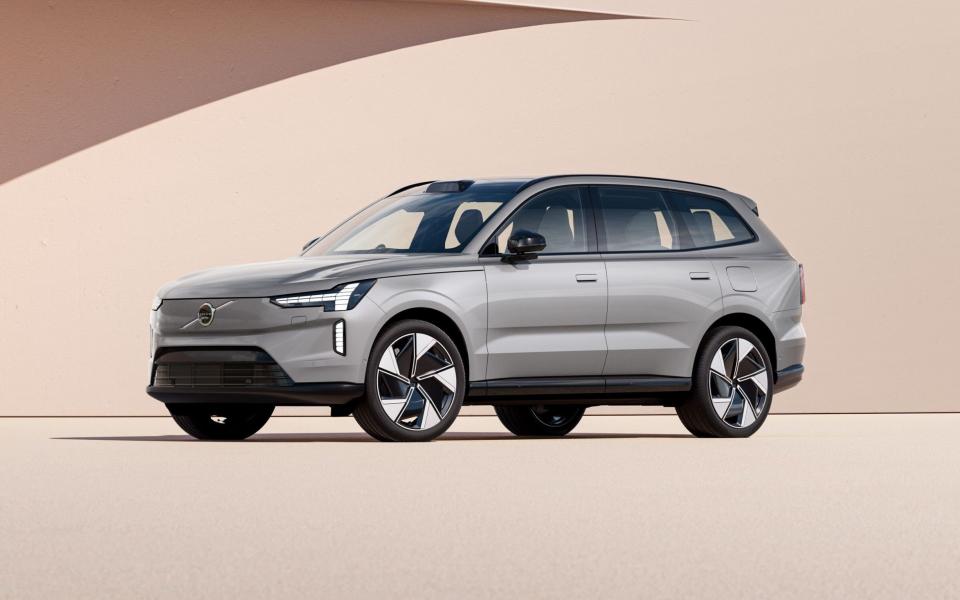Mercedes-Benz EQS SUV review: comfort and joy – but you might wonder where your £128,000 has gone

You may recall that, two years ago, Mercedes-Benz launched the EQS – to all intents and purposes an electric alternative to its all-conquering S-Class saloon.
However this car is not the EQS, despite its name and badging. It is the EQS SUV; an SUV version of the EQS, in other words – in much the same way that Mercedes will also sell you an estate version of the E-Class saloon.
On the face of it, this seems logical. The theory is sound. If you want an EQS, you can have the choice of either a saloon or an SUV. And yet, in practice, it doesn’t quite work.
Pros
Endlessly comfortable
Lavishly equipped
Roomy interior
Cons
Risks feeling too similar to cheaper Mercs
Range not terrific given battery size
So-so boot space
Marketing speak
That’s because while Mercedes has named this car as though it is a part of the EQS range, it’s marketing this seven-seater as a model in its own right. Which means it – and its customers – must make sure they say ‘SUV’ after ‘EQS’, to make sure nobody gets confused between this and the original, four-door model.
That isn’t likely to be too much of a problem. What might be, however, is the fact that naming its new car in this way suggests that it is a derivative. Yet this is a high-end electric SUV and it therefore costs almost £130,000 – and if you’re spending that sum on an SUV you want it to feel special. You probably don’t want to feel as though it’s a derivative of something cheaper.

It’s why, for example, Porsche will sell you a Cayenne, rather than a Panamera Cross Turismo, and why Bentley has a Bentayga rather than a Flying Spur XL.
The EQS SUV isn’t helped by its styling. Clearly, there’s been a conscious effort to make this look like an SUV version of the EQS. The result, however, comes across as rather generic – take off the badges, and there isn’t one angle from which you could say with absolute confidence that it’s a Mercedes.
But more than that, it reinforces the idea that this is a derivative of a less expensive model rather than a car that stands in its own right. That sense is only hammered home when you clap eyes on the smaller EQE SUV, which Mercedes is releasing at the same time, using the same marketing strategy.
This, you’d be correct in thinking, is an SUV version of the EQE saloon, which makes it cheaper still – and given the EQE is a shrunken EQS, so the EQE SUV is a shrunken EQS SUV – to the point that if you put pictures of the two side-by-side, you’ll struggle to tell them apart.
Lovely interior
Climb inside and it’s a similar story. The EQS SUV benefits from the same dashboard architecture as the EQS. And given this is all but identical to that of the EQE, what you end up with is a cockpit that looks virtually identical to the one in a car costing almost half the price. And that’s fine – but it means that the EQS SUV doesn’t feel all that special or unique.
Yet for all that it’s a lovely place to sit, with a big swathe of open-pore wood. If you upgrade from the AMG Line Premium Plus model tested here to the Business Class version you get a huge, expansive screen that sweeps the full width of the dashboard and incorporates the central touchscreen. It’s very flashy and a joy to use, but do just remember the potential cost involved if it goes wrong just after the warranty expires.

As standard, you get the same large, portrait-oriented touchscreen we’ve already seen in several other Mercedes, which works well, with intuitively laid out menus, snappy touch response, clear, sharp graphics and some of the best on-screen climate controls we’ve yet seen.
The virtual dials are equally crisp and easy to read, as is the head-up display. And it’s only as you take in your surroundings that the differences between the EQS SUV and its lesser stablemates start to reveal themselves. Even in this entry-level version, you get big, well bolstered, diamond-quilted leather chairs, a panoramic sliding roof and a Burmester sound system, all as standard.
The ambient lighting can be set to just one shade of your choice, or can send swirls of colour flowing around you; there are heated seats, not only in the front but also in the middle and rearmost rows of seats; there are even four zones of climate control.

Space, as you might expect, is ludicrously generous. In fact, the EQS SUV is best experienced from its middle-row seats, which offer more leg room than you’ll ever need. Our test car was a five-seater. In the UK the seven-seat configuration is standard, so I can’t tell you how usable the rearmost row is.
What we can say is that, with the rearmost row folded down, you get 565 litres of boot space. Reasonable, if not outstanding compared with its petrol- and diesel-powered equivalents, and less than you’ll get in the imminent Volvo EX90. That’s largely down to the challenges of packing in 108.4kWh-worth of batteries.
Size matters
That’s a sizeable amount and big batteries mean big weight. As, of course, do the two electric motors, all seven seats and the high level of equipment. Indeed, it tips the scales at 2.8 tonnes.
This rather neatly illustrates the law of diminishing returns that comes into play when trying to engineer big SUVs. Because to get decent range figures with those bluff aerodynamics, you need a large battery – but the more battery you add, the more weight you add and the more you impact the range.
So even with all that battery on board, the EQS SUV can only muster an official range of 365 miles – less than you can get in a Ford Mustang Mach E – which will equate to between 250 and 300 miles in the real world.

It’ll also mean charging at home on a 7.4kW wallbox from 10 to 100 per cent will take almost 17 hours – get home from a long journey, in other words, and you’ll have to leave it overnight and for most of the next day before it’s back up to full capacity.
A peak of 200kWh means DC charging will be faster – expect 31 minutes to get from 10 to 80 percent – though you’ll have to find a charger that can match that pace; on a more widely available 150kW charger, it’ll take 41 minutes.
Oh, and because it weighs so much, don’t forget you won’t be able to tow anything more than a micro-caravan on a standard car licence issued after 1996, because you’ll exceed the permitted maximum authorised mass.
On the road
So heavy is it that you might expect the EQS SUV to feel rather unwieldy and intimidating, yet that isn’t the case. The way the bodywork tapers and curves, the good visibility afforded by the large windows and a remarkably tight turning circle all mean this isn’t an intimidating car to drive and it’s easy to place on the road.

It is staggeringly comfortable, too. The air suspension in its most comfortable setting does allow a little bit too much waft and wallow if you crest longer undulations too quickly, but nowhere near as much as you might expect given the EQS SUV’s mass; meanwhile, it does a splendid job of smothering the more niggly stuff. Sharp-edged ruts and potholes generate barely any more than a distant tremor.
Want more body control? Flick it into Sport mode and the dampers firm up; those tremors are consequently amplified – although still not to a point at which they become intrusive – but the waft and wallow is gone.
In this mode, you can also hustle the EQS SUV at a fairly decent lick; it doesn’t feel entirely happy about it, as you’d expect given its weight, but it changes direction surprisingly swiftly and there’s plenty of grip and traction.
You won’t be taking the scenic route home as a matter of course, but it’s reassuring to know that when you want – or need – to fling the EQS SUV around, it won’t go to pieces.

The standard EQS450 SUV isn’t exactly short of power – you get 355bhp, enough to propel it to 62mph from standstill in six seconds exactly. You can upgrade to the EQS580 SUV if you feel the need for more; with 537bhp on tap, it’ll do the same sprint in only 4.6 seconds.
But you’ll pay an extra £10,000 for the privilege, and given that the EQS SUV is so good at relaxed motoring – and plenty quick enough in its standard form – we probably wouldn’t bother.
The Telegraph verdict
The sheer weight of the EQS SUV makes it hard to justify on the basis of sustainability, but that’s a criticism that can also be levelled at any of these vast, resource-heavy electric SUVs. And, of course, we should keep in mind that this is the S-Class of electric SUVs and no S-Class was ever going to repair the hole in the ozone layer.
Where the EQS SUV might struggle more is in its superficial ordinariness. With an interior that’s shared, by and large, with its cheaper stablemates and exterior styling that verges on the bland, you might find its price hard to justify, especially given that the electric Range Rover, arriving next year and expected to cost about the same, is bound to feel a little more special.
Which is a bit of a shame, because beneath its slightly underwhelming skin this is a plutocratic and cosseting luxury SUV that does what it sets out to do very well. It feels, in other words, exactly as you’d hope an electric S-Class SUV would. If you can get past the generic looks, then, you’ll probably like what you’ll find.
The facts
On test: Mercedes EQS450 SUV AMG Line Premium Plus
Body style: five-door SUV
On sale: now
How much? £129,170 on the road (range from £129,170)
How fast? 130mph, 0-62mph in 6.0sec
How economical? 3.1mpkWh (WLTP Combined)
Electric powertrain: 2x AC permanent magnet synchronous motor, 108.4kWh battery (usable), 200kW on-board DC charger, Type 2/CCS charging socket
Electric range: 365 miles (WLTP Combined)
Maximum power/torque: 355bhp/588lb ft
CO2 emissions: 0g/km (in use), 39g/km (well-to-wheel)
VED: £0
Warranty: 3 years / unlimited miles
Spare wheel as standard: no (not available)
The rivals
Tesla Model X Plaid
1020bhp, 333 miles (est’d), £145,000 on the road (est’d)
You can only pre-order a Model X at the moment; there’s no word yet on when deliveries will restart, having been paused in the UK for several months. Still, on the assumption they will, this is still the EQS SUV’s most obvious competitor and gives you much more bang for your buck. Mind you, it suffers the EQS’s problem of feeling too much like a lesser Tesla inside – and those upward-opening ‘Falcon’ doors are a potentially costly gimmick.

Volvo EX90 Twin-Motor Ultra
402bhp, 364 miles (est’d), £100,555 on the road
The fully electric EX90 has just been revealed, so we’ve yet to drive it; we’ll let you know what it’s like just as soon as we do. Either way, that Volvo can charge £100,000 for one of its cars proves just how the brand has moved up in the world. Next to the EQS SUV, though, the EX90 looks a bargain, with more power, more space and almost as much range for almost £30,000 less. Your move, Mercedes.

Range Rover D350 Autobiography LWB 7st.
345bhp, 35.2mpg, £128,720 on the road
The Range Rover hasn’t yet gone electric, but this diesel version is a terrific alternative; it both looks and feels far more special than the EQS SUV, and drives just as comfortably. You get a larger boot, too, and more room in the rearmost row of seats. While it could hardly be described as fuel-efficient, it won’t cost you the earth to run – and, of course, it won’t need nearly 17 hours to charge at home.


 Yahoo News
Yahoo News 
